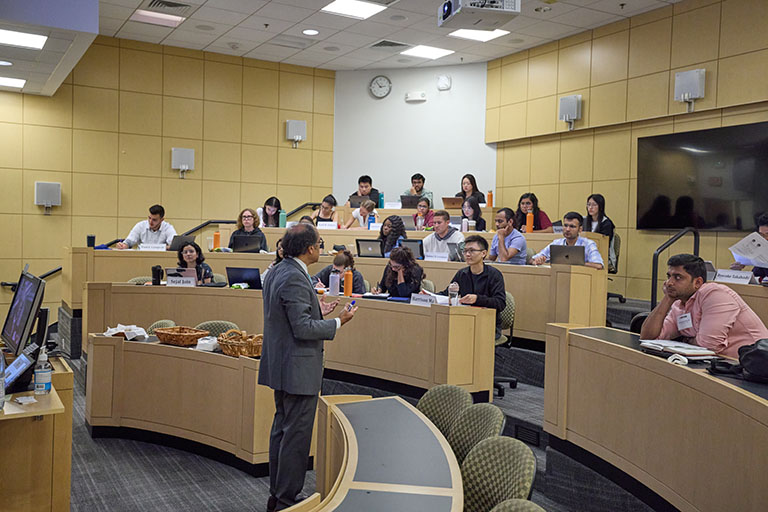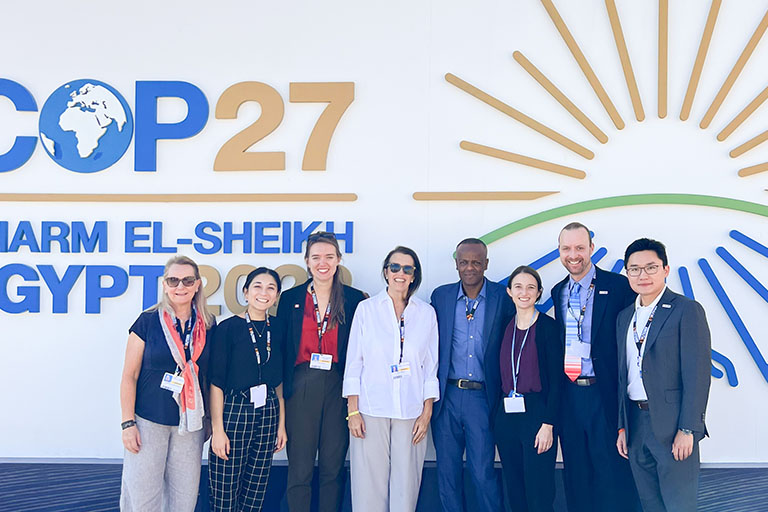-

Hear from Professor Monica Toft
Learn how Professor Monica Toft is shaping the study of global affairs and diplomacy at Fletcher.
Hear from Prof. Toft -

Explore Fletcher academics in action
Fletcher Features offers insights, innovation, stories and expertise by scholars.
Get global insights -
Get application tips right from the source
Learn tips, tricks, and behind-the-scenes insights on applying to Fletcher from our admissions counselors.
Hear from Admissions -

Research that the world is talking about
Stay up to date on the latest research, innovation, and thought leadership from our newsroom.
Stay informed -
Meet Fletcherites and their stories
Get to know our vibrant community through news stories highlighting faculty, students, and alumni.
Meet Fletcherites -

Forge your future after Fletcher
Watch to see how Fletcher prepares global thinkers for success across industries.
See the impact -

Global insights and expertise, on demand.
Need a global affairs expert for a timely and insightful take? Fletcher faculty are available for media inquiries.
Get in Touch
COP30: Key Issues and Stakes for Global Climate Policy
Fletcher experts offer insight into the politics and priorities driving international climate talks

Photo: logo courtesy of COP30 Brasil, placed over image of Belém landscape
The 30th United Nations Climate Change Conference (COP30) is set to be a defining moment in the fight against climate change. With global temperatures rising, climate financing under scrutiny and nations divided over how to accelerate the energy transition, the stakes have never been higher.
From climate justice and biodiversity protection to adaptation strategies and the role of developing nations, COP30 will bring difficult negotiations that could shape policies for decades to come. This page, featuring commentary from Fletcher's Center for International Environmental & Resource Policy (CIERP), Climate Policy Lab (CPL), faculty, students and other leaders in the Fletcher community, unpacks and furthers the discussion on the core issues driving global climate negotiations.
For interview opportunities with Fletcher faculty, please contact Katie Coleman at katie.coleman@tufts.edu.
COP and Grassroots Activism
(October 5) While the leaders of global climate diplomacy prepare to attend COP30 in Belém this November, environmental defenders engaged in grassroots climate activism continue to face immense, sometimes fatal risks in the name of climate justice. Efraín Fueres, an indigenous land defender, was shot in Ecuador on September 29. Just a few weeks earlier, an environmental activist in Indonesia was found dead. In July, forest defender Hipólito Quispe Huamán was killed while driving in Peru.
Targeted attacks of environmental defenders have been on the rise for the past 20 years. In 2024 alone, over 146 environmental defenders were reported to be murdered or disappeared. The vast majority of these killings took place in Latin America. While it is promising that the COP30 Action Agenda makes specific note of climate justice, highlighting structural and socioeconomic factors that contribute to climate related inequality, there should be direct acknowledgment of our collective failure to protect environmental defenders embarking on the daily, difficult work of grassroots activism.
Hopefully, summit leaders will take advantage of the unique forum that COP poses to engage with grassroots activists on sustaining meaningful allyship (see Circle of People). But it is up to all attendees–scientists, business leaders, academics, and others–to protect our environmental defenders by taking their demands seriously and prioritizing accountability in light of these horrific deaths.
Oceans in Focus
By Marcia Moreno-Báez, Research Professor
(September 30) The IPCC's Special Report on the Ocean and Cryosphere shows how rapidly seas are warming, rising and reshaping ecosystems. These shifts threaten coastal communities, fisheries and island states, but also highlight where targeted finance and policies could make the greatest difference.
Belém, with its Amazon setting, offers a symbolic bridge between land and sea. The UNFCCC’s Ocean & Climate Change Dialogue lays the groundwork to integrate oceans into climate negotiations.
One clear opening is finance, front and center at last summer’s U.N. Ocean Conference. COP30 offers the chance to standardize eligibility criteria, strengthen safeguards for communities and expand MDB-backed blue bonds. These models offer templates to make blue finance credible and catalytic.
The New Collective Quantified Goal on Climate Finance also helps build momentum to prioritize ocean and coastal resilience. Dedicated windows for small island and coastal states could channel resources where they are most needed to restore ecosystems and support relocation planning when adaptation reaches its limits.
Brazil’s leadership also brings the chance to stand up for social and ecological justice. Linking watershed management with coastal protection could deliver powerful nature-based solutions to protect river basins, safeguard biodiversity and sustain communities.
Most importantly, COP30 can embed oceans in future climate targets. Encouraging countries to include explicit ocean commitments in their NDCs would signal that oceans are no longer peripheral, but central to climate ambition and life on Earth.
The Chinese Pledge
By Zheng Cui, Junior Research Fellow
(September 26) At the U.N. General Assembly, Xi Jinping pledged China would cut economy-wide greenhouse gas emissions 7–10% below peak levels by 2035 and lift non-fossil energy to “30%+,” while increasing wind and solar capacity sixfold from 2020 levels. It is China’s first explicit commitment to absolute cuts. Symbolically important but underwhelming, the pledge comes as the world’s largest emitter heads into COP30.
Beijing has a credible execution record: it reached the 1,200-GW wind-plus-solar milestone six years early and, by spring 2025, wind and solar capacity surpassed thermal power. Those feats underpin China’s de facto leadership in green technology, particularly affordability and scale.
But leadership is more than megawatts. Grid bottlenecks and curtailment mute renewable output, and continued coal build-out clouds the signal. The new 2035 targets are conservative and achievable with minimal effort. Without stricter limits on coal and stronger grid/storage reforms, China risks being seen as the world’s clean-tech manufacturer rather than its climate pace-setter.
What to watch: first, whether Beijing translates the 2035 headline into a transparent peak-year baseline and decline pathway. Second, near-term policies that accelerate transmission, set storage mandates and prioritize clean dispatch. Third, caps on new coal approvals and a timetable to cut utilization. Delivering on these would turn a cautious pledge into genuine leadership as other major economies grapple with ambition gaps.
The bar for “leadership” isn’t perfection. China has the tools and the stage to prove it.
Adaptation at COP30
By Bethany Tietjen, Predoctoral Research Fellow
(September 24) Though much focus ahead of COP30 has been on updating countries’ Nationally Determined Contributions (NDCs) under the Paris Agreement, updates to National Adaptation Plans (NAPs) are also due in 2025. Parties are expected to review progress on formulating and implementing NAPs, which outline countries’ climate risks, adaptation priorities and finance needs.
Also planned, though not yet listed in the provisional agenda, is the conclusion of the two-year UAE-Belém work program on indicators for the Global Goal on Adaptation (GGA). Under the work program, a team of experts have developed and refined a list of 100 indicators to help countries track and measure their adaptation progress. Unlike climate mitigation, which can be tracked in emissions reductions, adaptation has no single metric for measuring success. The GGA indicators offer a framework to help countries assess adaptation outcomes and will hopefully be adopted this year in Belém.
While COP30 has been labeled an “implementation COP” and is not expected to deliver major new agreements, these activities could set the tone for more consistent measurement and renewed momentum on adaptation. Ultimately, the usefulness of the NAPs and GGA indicators will depend on whether they are backed by scaled up and predictable adaptation finance. With the pledge to double adaptation finance expiring in 2025, Parties face pressure to establish a new global adaptation finance target at COP30 that brings us closer to addressing the scale of adaptation needs.
The Persistent Disconnect
By Kate Chi, Junior Research Fellow
(September 20) The upcoming COP30 stands as a milestone, marking three decades of United Nations climate negotiations and the tenth anniversary of the Paris Agreement to limit global mean temperature rise. COP30 sets the action plan of 6 thematic axes, guided by the Global Stocktake—a “report card” assessing global progress towards collective climate objectives. However, the first Stocktake outcome in 2023 assessed that Parties are not on track to achieving the Paris goals and underscored the urgency of low-carbon energy transition. U.N. Secretary-General António Guterres delivered a statement this July warning that countries continuing to rely on fossil fuels are “sabotaging” their economies and locking themselves into stranded assets.
Still, fossil fuel exploitation persists. The United States, the world’s largest oil and gas producer, withdrew again from the Paris Agreement in early 2025, while projections indicate continued growth in U.S. crude oil and natural gas production through 2030. Brazil, the host of the COP30, also faces scrutiny for auctioning new oil exploration rights months ahead of the Conference and for its plans to expand oil and gas production by 20% by 2030. Labeled a ‘doomsday auction’, the Brazilian government plans to offer 47 oil blocks in a vulnerable part of the Amazonas basin—an area the fossil fuel industry views as a promising exploration zone, yet breaches Indigenous rights and environmental governance. These contradictions highlight the widening disconnect between stated climate ambitions and the persistence of fossil fuel development.
Professor Ken Pucker speaks to Trellis about shifts in corporate sustainability goals. (October 3)
Professor emeritus William Moomaw comments for Mongabay on a new study revealing challenges for reforestation. (October 2)
In his regular column, senior fellow Pratik Kanjilal describes fissures in international cooperation on climate change mitigation. (September 19)
Dean Kelly Sims Gallagher speaks to The New York Times about China's green technology ambitions. (September 18)
HeatMap interviews Professor Barbara Kates-Garnick about changes in U.S. policy towards offshore wind energy. (September 18)
Postdoctoral scholar Abay Yimere appears on public radio's The World to discuss the African Climate Summit. (September 9)
The Guardian quotes postdoctoral scholar Abay Yimere's analysis on Africa's role in the global climate fight. (September 8)
Professor Barbara Kates-Garnick compares the environmental policies of U.S. Presidents Donald Trump and Ronald Reagan. (August 26)
Senior fellow Joshua Lincoln assesses the state of U.N. negotiations for a global plastics treaty. (August 21)
Professor Ken Pucker comments on efforts to reduce the carbon emissions associated with the global clothing industry. (August 21)
Professor Barbara Kates-Garnick speaks to Canary Media about Donald Trump's approach to offshore wind energy. (August 19)
Postdoctoral scholar Abay Yimere writes a piece for The Conversation analyzing the African Climate Summit. (August 17)
Forbes quotes commentary from Professor Ken Pucker on how fast-fashion impacts global carbon emissions. (August 14)
Professor Barbara Kates-Garnick speaks to The New York Times about changes to U.S. energy policy. (August 7)







